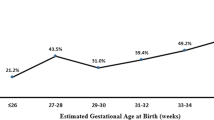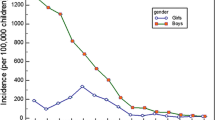Abstract
Purpose
Clinical observations showed a higher incidence rate of inguinal hernia (IH) in preterm infants. In this study, we calculated the incidence rate of preterm IH from the National Health Insurance Research Database (NHIRD) of Taiwan.
Methods
From NHIRD, 92,308 subjects born in the year of 1997–2005 were randomly selected as the study cohort. The medical claims of these subjects from birth to 6th year of age were analyzed. Preterm births were defined using ICD code 765.1*. Risk factors such as birth weight, lung disorders, and ventilator supports before IH repairs were investigated. The risk of incarceration and bowel resection were also evaluated.
Results
From 92,308 subjects, 2560 preterm births were identified. IH was repaired in 231 preterm (9.02%) and 3650 term subjects (4.07%). Male (preterm 13.3% and non-preterm 6.3%) had more hernia repairs than female (preterm 3.8% and non-preterm 1.6%). The incidence rate of IH is 13.7% for those under 1500 g, 8.2% for those 1500–1999 g, 7.7% for those 2000–2499 g, and 6.3% for those above 2500 g. The incidence rate of IH in preterms with past history of lung disorders and ventilation supports is 8.7 and 13.6%, respectively. There was no significant difference in the incidences of incarceration and bowel resection between preterms and non-preterms.
Conclusions
Birth weight under 2500 g is a significant risk factor for IH repairs. Other risk factors are male gender, past history of lung diseases, and ventilator supports.
Similar content being viewed by others
References
Pan ML, Chang WP, Lee HC, Tsai HL, Liu CS, Liou DM, Sung YJ, Chin TW (2013) A longitudinal cohort study of incidence rates of inguinal hernia repair in 0- to 6-year-old children. J Pediatr Surg 48:2327–2331
Kumar VH, Clive J, Rosenkrantz TS, Bourque MD, Hussain N (2002) Inguinal hernia in preterm infants (< or = 32-week gestation). Pediatr Surg Int 18:147–152
Glick PL, Boulanger SC (2012) Inguinal hernias and hydroceles. In: Coran AG (ed) Pediatric surgery, 7th edn. Elsevier, Amsterdam, pp 985
Sampaio FJB, Favorito LA (1998) Analysis of testicular migration during the fetal period in humans. J Urol 159:540–542
Burgmeiera C, Dreyhauptb J, Schier F (2015) Gender-related differences of inguinal hernia and asymptomatic patent processus vaginalis in term and preterm infants. J Pediatr Surg 50:478–480
Boocock GR, Todd PJ (1985) Inguinal hernias are common in preterm infants. Arch Dis Child 60:669–670
Rajput A, Gauderer MWL, Hack M (1997) Inguinal hernias in very low birth weight infants: incidence and timing of repair. J Pediatr Surg 27:1322–1324
Peevy KJ, Speed FA, Hoff CJ (1986) Epidemiology of inguinal hernia in preterm neonates. Pediatrics 77:246–247
Duggan EM, Patel VP, Blakely ML (2015) Inguinal hernia repair in premature infants: more questions than answers. Arch Dis Child Fetal Neonatal Ed 100:F286–F288
Sveger T, Ohlsson K, Polberger S, Noack G, Mörse H, Laurin S (2002) Tracheobronchial aspirate fluid neutrophil lipocalin, elastase, and neutrophil protease 4-alpha-1-antitrypsin complexes, protease inhibitors and free proteolytic activity in lung distress syndrome. Acta Pediatr 91:934–937
Crofton PM, Shrivastava A, Wade JC, Stephen R, Kelnar CJH, McIntosh N, Lyon AJ (2000) Effects of dexamethasone treatment on bone and collagen turnover in preterm infants with chronic lung disease. Pediatr Res 48:155–162
Misra D, Hewitt G, Potts SR, Brown S, Boston VE (1994) Inguinal herniotomy in young infants, with emphasis on premature neonates. J Pediatr Surg 29:1496–1498
Author information
Authors and Affiliations
Corresponding author
Ethics declarations
Conflict of interest
The authors declare that they have no conflict of interest.
Research involving human participants and/or animals
All procedures performed in studies involving human participants were in accordance with the ethical standards of the institutional and/or national research committee and with the 1964 Helsinki declaration and its later amendments or comparable ethical standards. For this type of study, formal consent is not required. This chapter does not contain any studies with animals performed by any of the authors.
Informed consent
All information obtained from the national health insurance database was deidentified, so theoretically, it is impossible to query the data alone to identify individuals at any level using this database. For this type of study, formal consent is not required.
Rights and permissions
About this article
Cite this article
Fu, YW., Pan, ML., Hsu, YJ. et al. A nationwide survey of incidence rates and risk factors of inguinal hernia in preterm children. Pediatr Surg Int 34, 91–95 (2018). https://doi.org/10.1007/s00383-017-4222-0
Accepted:
Published:
Issue Date:
DOI: https://doi.org/10.1007/s00383-017-4222-0




